Featured

Race against time to treat hump-nosed pit viper bites
The hump-nosed pit viper has many oddities — starting with its name — but the most fearsome is the fact that there is no antidote available for its deadly venom.
That makes the hump-nosed pit viper (Hypnale hypnale), also called the hump-nosed moccasin for its pointed and upturned snout, a major killer endemic to Sri Lanka and the Western Ghats, a mountain range of South India. The standard polyvalent antivenom used for the four most poisonous snakes of the region — the Indian cobra (Naja naja), Indian krait (Bangarus caeruleus), Russell's viper (Daboia russelii) and Saw-scaled viper (Echis carinatus) — does not work on hump-nosed pit viper venom.
A: Russell's viper/ B:Indian cobra/ C: Saw-scaled vipe/ D: Krait
Worse, the polyvalent antivenom, which is made in India and exported to Sri Lanka and several African countries, can result in massive allergic reactions when administered to a victim bitten by a hump-nosed pit viper or by a species other than the Big Four.
Following detailed studies in the 1990s, the hump-nosed pit viper was recognised as a medically important snake. As a result, researchers began questioning the prevalence of the Big Four in clinical, toxicological and biological studies, while other venomous species have remained neglected. Even now, most of the scientific literature on the hump-nosed pit viper is confined to Southern India or Sri Lanka.
“Because the hump-nosed pit viper was not seen to be as deadly as the Big Four, no study on its venom and treatment was carried out, resulting in high levels of mortality and morbidity,” says Sajeeth Kumar, researcher at the Government Medical College in Kozhikode, Kerala, and lead author of a study on poisonous snakes published in the International Journal of General Medicine.
“Where the bite of the hump-nosed pit viper was thought to result only in local envenoming it turned out that there were serious systemic effects as well with more than one organ affected,” Kumar tells SciDev.Net. “Our study of 1,500 toxic snakebite cases showed that hump-nosed pit viper envenomation typically brings on acute kidney injury leading to corticoid necrosis and death.”
Most bite victims suffer from coagulopathy, a condition in which the blood loses its ability to clot, resulting in internal bleeding that may last six days on average, calling for close medical management.
“Finding the particular component in hump-nosed pit viper venom that stops blood from clotting could be of major therapeutic importance,” says Kumar. He points to studies aimed at developing medicines from viper venom, such as blood thinners, that can prevent the unwanted clot formation responsible for cardiac arrest, stroke and hypertension.
The leading cause of death from hump-nosed pit viper bites is capillary leak syndrome, a condition in which fluid and proteins leak out of tiny blood vessels into surrounding tissue. This results in dangerously low blood pressure and a decrease in blood plasma volume.
“Capillary leak syndrome is refractory to any standard treatment measure and adds to the complications of treating a venomous hump-nosed pit viper bite,” says Kumar. “This is why lack of awareness, delayed hospitalisation and treatment by non-medical personnel add to the risk of mortality where hump-nosed pit vipers are concerned.”
In the absence of antivenom, basic medical facilities needed for the management of hump-nosed pit viper bites include blood dialysis machines that can help save the kidneys, ventilators in the event of respiratory distress and fresh, frozen plasma for use on patients that show signs of coagulopathy.
 English: Highland Hump-nosed Pit Viper Binomial: Hypnale nepa. Sinhala: කදුකර මූකලන් තෙලිස්සා
English: Highland Hump-nosed Pit Viper Binomial: Hypnale nepa. Sinhala: කදුකර මූකලන් තෙලිස්සා
“It is clear that we urgently need to develop and manufacture antivenom with activity against hump-nosed pit viper venom,” says Kumar. “We are hopeful that the polyvalent antivenom, presently undergoing clinical trials in Sri Lanka, would be useful in South India.”
The polyvalent antivenom being developed by Sri Lanka’s University of Peradeniya, in close collaboration with the Instituto Clodomiro Picado in Costa Rica, contains antivenom specific to Sri Lankan hump-nosed pit vipers.
Sri Lanka initiated the project after it was discovered that polyvalent antivenom being imported from India was not only useless against the hump-nosed pit viper, but also triggered severe allergic reactions in an unacceptably large number of cases.
Adverse reactions to the Indian antivenom makes it “part of the problem” of treating snakebite, says Sarath Kotagama, conservationist and emeritus professor of environmental sciences at the University of Colombo. “There are differences in the venom of Indian and Sri Lankan snakes, although both belong to the same species.”
According to Indian experts, variability in composition and potency of snake venom is common across species, so much so that India is now putting in place a policy of producing antivenom for specific areas. “Ecological and environmental factors, gender, age, diet and season are among factors that affect snake venom composition,” says Kartik Sunager, a researcher on snake venom at the Indian Institute of Science in Bangalore.
The new, polyvalent antivenom has demonstrated, in pre-clinical trials, capability in neutralising the venom of Sri Lanka’s three main viperid species — the Russel’s viper, the saw-scaled viper and the hump-nosed pit viper. The inclusion of hump-nosed pit viper antibodies makes it the only antivenom available for the treatment of this species anywhere, but commercial manufacture is yet to begin.
“The danger from hump-nosed pit viper bites also has to do with its mottled grey and brown colouring overlaid with a pattern of dark spots that camouflages the nocturnal animal well as it rests during the day among dead leaves, bushes and fallen logs,” says V.T. Vijayakumar, an environmentalist who specialises in snakes. “Though slow-moving, it has an irritable disposition when disturbed and strikes fast.”
“It is well for unsuspecting farmers and trekkers to remember these attributes because, for now, the only way to prevent hump-nosed pit viper envenomation is to stay clear of the reptile,” Vijayakumar says.
This piece was produced by SciDev.Net’s Global desk.
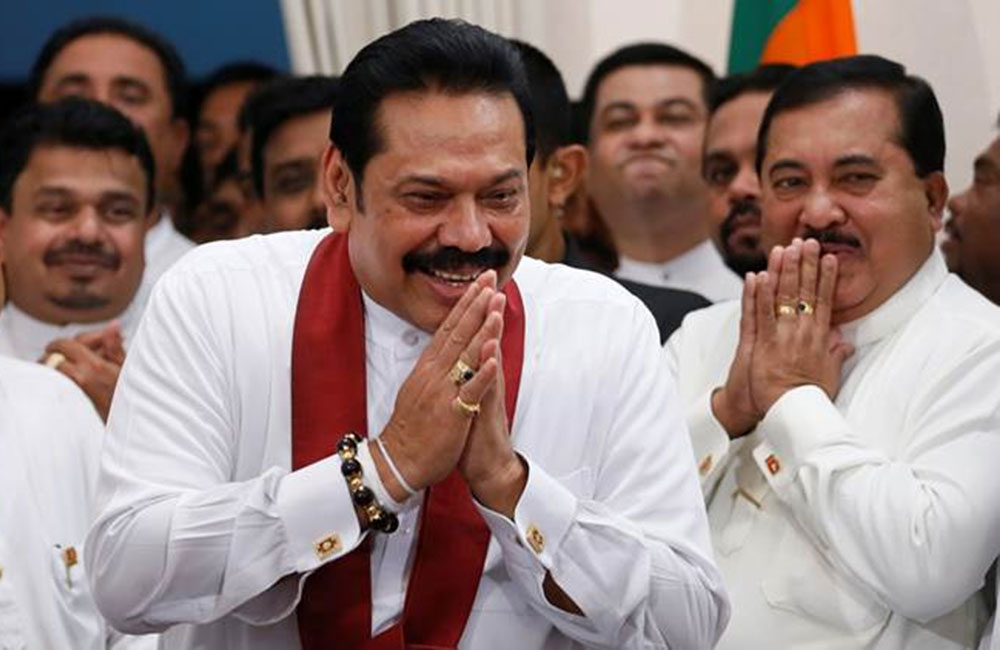
Sri Lanka: The Return of a Supremacist
by Anura Gunasekera
( November 3, 2018, Colombo, Sri Lanka Guardian) Never has the truth of that hackneyed cliche’, “ in politics there are no permanent friends or permanent enemies, but only permanent interests”, been so aptly demonstrated than in the drama that is being currently played out in our theatre of the absurd.
In an act of unbelievable political expediency President Sirisena betrayed all the noble principles of the Rule of Law, Constitutional Democracy and Good Governance that he so sanctimoniously vowed four years ago to uphold, and handed back the reins of power to the supremacist whom he ousted; at the risk of his life as Sirisena himself said at that time.
Maithripala Sirisena, a colourless man with a colourless career, for a greater proportion of that an unthreatening presence to his more ambitious colleagues, will now be remembered for ever for two epochal events, both occurring in the evening of his political life. Without those two episodes, in the normal course of events he would have faded away as many other politicians of his calibre, eventually to be forgotten even by his constituents.
The first event was when, in November 2014, he stood before the nation, flanked by his campaign companions and supporters and declared his challenge to the most powerful and most charismatic politician this country has seen since Independence. In the context of the time and the nature of his opponent it was a courageous gesture and a moment of genuine greatness in an otherwise singularly unremarkable life
Given the history of the Mahinda Rajapaksa operational style, the possible risk to his life was not an exaggeration. The number of Rajapakse opponents and critics who were neutralized through violent death, inexplicable disappearance, summary dismissal from public office, incarceration and expulsion or permanent flight to other countries, represents a compelling body of evidence of the peril inherent in throwing down the gauntlet at Mahinda Rajapaksa.
The second event was just a couple of days ago, when with a terse message addressed to sitting Prime Minister Ranil Wickramasinghe, he betrayed the trust of 6.2 million people and released to the land the spectre that he had once helped to contain. With one stroke of his pen he re-launched the Rajapakse dynastic project which he himself once helped to derail. Unless something miraculous happens the project is now on track and in my view miracles do not happen. The Rajapakse cabal will not make the same mistakes again. It is not that they will reform. They will simply act with greater ruthlessness, with excessive care and certainty, ensuring that the opposition will not rise again.
Irrespective of the arguments in support of Sirisena’s action, particularly by G.L. Peiris, that unrepentant apologist for a succession of unscrupulous rulers, the entire episode of unseating Wickramasinghe and appointing Rajapakse carries with it all the elements of a constitutional coup, secretively configured and suddenly executed, carefully hidden from the victim till the very end. The Parliament, the Speaker and the nation, which includes the many people who propelled both the victim and the perpetrator in to power, were kept in the dark. It is something that should never have happened in a robust democracy. It is exactly what happens in a typical “ banana republic”, which the Rajapaksa regime helped to usher in. So far there has been no shooting, as would be normal in a banana republic, except in a parallel development at the Ceypetco office. But, unless there is a reasonable and democratically acceptable solution to this crisis, the shooting may also soon take place elsewhere.
What Sirisena has done is unparalleled in the recent history of a democratic entity, anywhere. In his subsequent address to the nation, he attributed to his action a long litany of purported misdeeds of the Prime Minister to which he also attached the cultural gulf that existed between the two of them. He stated that Wickramasinghe conducted the business of running the country in consultation with a just few close associates of his, who belonged to a privileged class. That statement would be laughable if not for the ominous consequences that the nation will face under Rajapakse rule. Does Sirisena seriously expect Mahinda Rajapaksa to act differently or more democratically than Wickramasinghe? Under Rajapakse the country will be governed by him, in consultation with his family and a couple of associates and friends, as was the case in the nine years of his stewardship. Of course, there will be one cardinal and singularly important difference between the two regimes. Under RW, criticism of the regime and its actions was permitted to a ridiculously candid extent. As opposed to that extreme of freedom of expression, one has only to consider the history of dissent under Rajapakse governance. Elaboration is unnecessary.
The constitutional and legal validity of RW’s removal will continue to be debated and can be finally resolved only by a ruling of the Supreme Court, assuming that the Rajapakse juggernaut that is rapidly steamrolling the RW administration will permit the issue to be canvassed at that forum. Mahinda Samarasinghe, over electronic media, triumphantly read out two letters, first the one addressed by the Speaker to the Acting Attorney General seeking clarity regarding the issue, and second the latter’s response to it. The reply appeared to be deliberately equivocal and certainly does not lay the matter to rest. As I, and I am sure most reasonable people in this country would understand it, the crucial determinant of legitimacy of governance is provided by a parliamentary majority. That I believe is the litmus test.
The prorogation of Parliament, notwithstanding all the logic attached to it by its proponents, is really a strategy to enable MR to gather, through cash purchase and any other means possible, the additional numbers he needs to legitimize an illegitimate promotion. The consolidation of Rajapakse power over the administration before reconvention of the Parliament, may eventually be an impediment to the delivery of an impartial legal opinion on the matter. The medium term objective of this constitutional coup is also to provide Sirisena a path, as a Rajapakse lackey, for a second presidential term, which the UNP would have denied him.
Irrespective of the legal and constitutional arguments, Sirisena, with his precipitate action, has set in motion an unprecedented constitutional crisis, locking two men in an internecine struggle for the prime ministerial seat and the right to govern. It has brought in to question the very validity and legitimacy of the existing constitution. Sirisena has created the conditions for civic disobedience in the country and that is an environment in which Mahinda Rajapaksa thrives. It has always been his political bread and butter. In a contest in which the quickest path to victory is the use and abuse of power and extra-legal intimidation, coercion and paramilitary suppression, there can be only one winner.
A perfect example of the above is the violence unleashed on Rupavahini and the ITN within hours of the proclamation of MR as Prime Minister. The unambiguous threats of forcible eviction of RW from Temple Trees, delivered by Wimal Weerawansa over electronic media are also simply echoes of his master’s voice.
It is not the purpose of this writing to either demonize Rajapakse or to sanctify Wickramasinghe. Both are unscrupulous in different ways and equally power-hungry. The difference with RW is that physical intimidation not excluding murder, is not the preferred method of stifling dissent and enforcing personal writ. What is at stake here is not the desirability of one individual over the other as the Prime Minister of the country but the legitimacy of democratic rule in the country. That is infinitely more important than the two individuals concerned.
Under a new Rajapakse rule one has to expect certain immediate and inevitable consequences. Firstly, there will be the dismantling of all the ongoing investigative processes in to financial irregularities and other crimes-including politically motivated murder- committed during the previous Rajapaksa regime. Selected criminals currently serving sentences are likely to be pardoned. It may not be too long before Galaboda Gnanasara exchanges his prison jumper for the robes that the Buddha sanctified and commences his rampage against Muslims. Duminda Silva may soon be addressing political rallies once more. The Armed Forces, the Police Department and the Judiciary are likely to see Rajapakse favorites in crucial positions. The areas of public service which are expected to deliver impartial outcomes to the nation will once again become willing adjuncts to the Rajapakse project.
President Sirisena has created a situation which is pushing a country, already beleaguered by a faltering economy and massive public fraud, in to total chaos at all levels. It is his responsibility now to resolve it. In January 2015 he said that he risked his life in order to do the right thing on behalf of the nation. That is exactly what he needs to do again, despite the certain knowledge that the risk is now of a greater magnitude. The Rajapaksa's do not forgive those who betray their cause; certainly not a second time.
On that eventful day four years ago, almost immediately after Maithripala Sirisena’s victory over Mahinda Rajapaksa was officially confirmed, I received a call from a friend, once one of the most highly regarded civil servants of then Ceylon, for long living in retirement in England. I was euphoric, as Sirisena’s win over Rajapakse represented to me, literally, the triumph of good over evil. My friend brought me down to earth with the words, “ Never place your faith in politicians. I have, for years observed their operations at close quarters. Sirisena himself may one day create the path for Mahinda Rajapaksa to come storming back”.
Those were the exact words of Neville Jayaweera, Chairman and Director General of the Ceylon Broadcasting Corporation from 1967-1970 and, at different times, Government Agent, Jaffna and Vavuniya. A prophetic utterance, from a man who had seen the best and worst of politicians, in an era when most politicians were of a different breed.
Maithripala Sirisena has defined himself, irrevocably, as a man of straw. Inevitably, it is they who are first consumed by the conflagrations that they fuel.
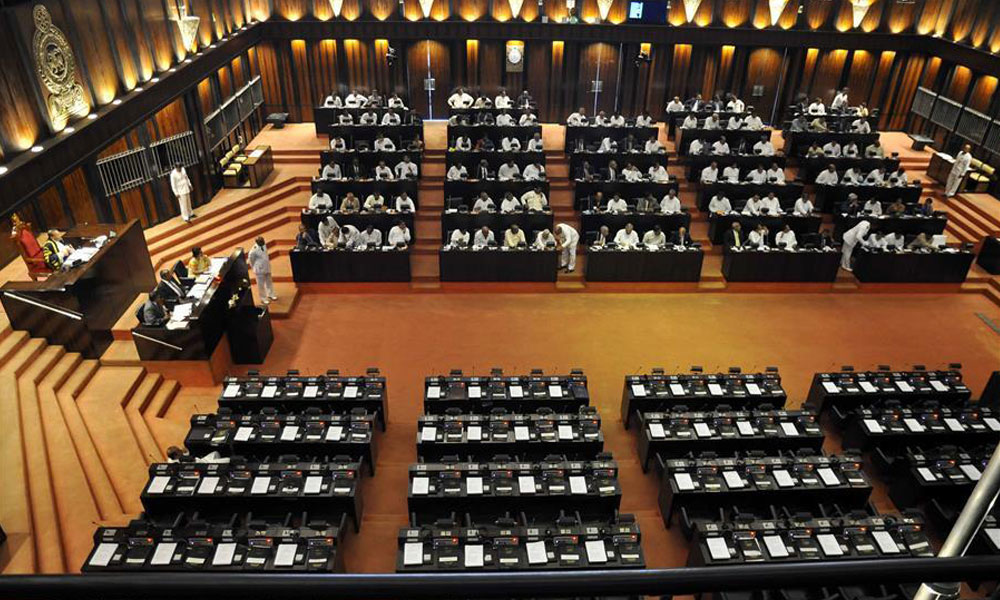
Sri Lanka's crisis of democracy
The tragicomedy revolves around three protagonists: President Maithripala Sirisena, former president Mahinda Rajapaksa and ousted Prime Minister Ranil Wickremesinghe. Sirisena served under president Rajapaksa in the Sri Lanka Freedom Party (SLFP) but decamped to run against and defeat Rajapaksa in the 2015 presidential election. Wickremesinghe’s United National Party (UNP) together with the country’s Tamil and Muslim minorities voted for Sirisena, who made Wickremesinghe his prime minister.
But the two failed to get along. Massive corruption among Wickremesinghe’s henchmen was one source of tension. Another was the class divide between a president with rural roots and the urban, liberal and pro-Western mindset of Wickremesinghe and his coterie. The latter’s disregard for Sirisena’s opinion when making important decisions was a constant irritant. So in October 2018 Sirisena overlooked constitutional constraints, fired Wickremesinghe and appointed Rajapaksa in his place.
When Rajapaksa was unable to command a majority in parliament, Sirisena prorogued and then dissolved the legislature. As the constitution prohibits dissolution until parliament has served four-and-a-half years of its five-year term, an interim Supreme Court decision stayed the dissolution of parliament until 7 December.
In the meantime, Asia’s oldest democracy claims two prime ministers. Wickremesinghe says Rajapaksa’s appointment is illegitimate and refuses to leave the prime minister’s residence, while Rajapaksa occupies the prime minister’s office and sits in the prime minister’s chair when parliament meets.
Tumultuous politics is compounding the crisis. Sirisena has reiterated he will not reappoint Wickremesinghe as prime minister. Rajapaksa’s ministers claim they do not require a parliamentary majority to oversee government, while the UNP, other parliamentarians and the Speaker demand that Rajapaksa prove a majority or sit in opposition. To boycott parliamentary sessions, Rajapaksa forces are scapegoating a hitherto dispassionate Speaker. And government servants are clueless as to who they should take orders from. All this amid a debt-ridden economy with a rising cost of living irking an increasingly disgruntled citizenry.
What are the troika’s motivations? Wickremesinghe has long craved the presidency and suspects he may prevail at the next election. While considered elitist and deaf to rural and grassroots concerns, the ongoing crisis allows him to mask such shortcomings and project himself as a saviour of democracy.
Despite committing to one term, Sirisena pines for another. The minorities and UNP supporters who voted for him in 2015 are not his base, and he has alienated SLFP supporters after defecting to the opposition and defeating Rajapaksa in the last election. Joining forces with Rajapaksa could bolster his popularity if they run as a team — Sirisena for another term as president and Rajapaksa as prime minister.
Rajapaksa cannot run for a third presidential term, but could dominate politics again as prime minister. Having defeated the separatist Liberation Tigers of Tamil Eelam (LTTE) and being an unabashed Sinhalese Buddhist nationalist, Rajapaksa has the support of Sri Lanka’s majority Buddhists. Had he waited until the next parliamentary elections, he would have easily won the prime ministership. But the fear that charges for crimes perpetrated during his presidency could be brought against him, his family and cronies before the next elections made Wickremesinghe’s ousting an attractive opportunity.
But the controversial way Rajapaksa recaptured power, combined with his supporters’ forceful take-over of media, telecommunications and government institutions, resembles a constitutional coup. Continuing to claim the prime ministership despite suffering multiple no-confidence votes in parliament has diminished his stature. Despite this, Rajapaksa and his party still stand to do well at the next elections.
Recent constitutional reforms granting more power to the prime minister’s office mean Rajapaksa could lord over a cabinet of his choice and marginalise Sirisena if he retains his position. Rajapaksa is vindictive and once he consolidates his position he may even pick a family member to replace Sirisena. What he ultimately wants is to create a political dynasty with his oldest son as president.
Sri Lanka’s rulers have repeatedly disregarded the country’s best interests for personal gain. And despite eliminating the LTTE, no one has compromised Sri Lanka’s long-term standing as much as Rajapaksa. Domestically, he sought to further marginalise the Tamils even while granting impunity to those attacking the island’s Muslims. (Most among these minorities did not vote for Rajapaksa and he believed that the narrative against them bolstered his Sinhalese Buddhist credentials.) He did so while undermining democratic institutions and establishing an increasingly authoritarian regime.
From a foreign policy standpoint, Rajapaksa facilitated increased Chinese presence in Sri Lanka through non-transparent and corrupt dealings. This relationship unsettled India and the United States but benefitted Rajapaksa and his following. His return to power has elated China while deepening concern in India and the West. It is a return that does not bode well for Sri Lanka’s recuperating democracy or regional relations.
*Neil DeVotta is Professor of Politics and International Affairs at Wake Forest University in the United States.

Constitutional Crisis in Sri Lanka: The Breakdown of Democracy
A constitutional crisis has entered its fourth day today, since Sri Lanka’s President Maithripala Sirisena appointed his erstwhile rival Mahinda Rajapaksa as Prime Minister, in a surprise move that shocked the island nation. The move came at dinnertime last Friday evening no sooner Sri Lankans had reached home after the workweek. It was preceded by minutes with the announcement that the President’s United People’s Freedom Alliance (UPFA) had left the National Government that had been formed with deposed Prime Minister Ranil Wickremesinghe’s United National Party (UNP). Sirisena previously served as a minister under Rajapaksa, a former two-term president, before defecting to successfully challenge him in January 2018, and deprive Rajapaksa of a third term.
Rajapaksa’s appointment as Prime Minister has sparked a constitutional crisis, with Wickremesinghe refusing to relinquish office on the grounds that the appointment violated the constitution. Wickremesinghe, whose security was withdrawn on Monday, remains holed up in his official residence. Rajapaksa supporters coercively took over control of state media institutions within minutes of his appointment by Sirisena. Cabinet appointments followed on Monday.
“What is unfolding in (Sri Lanka) is a coup. Coercively taking over institutions is the structure of a coup,” tweeted Dr. Nishan De Mel, Executive Director of Colombo-based think-tank Verité Research.
Constitutional lawyers argue that a prior provision of the constitution that gave the president power over appointment and dismissal of the Prime Minister was amended in 2015, such that the President no longer has the power of dismissal. Thus, the provision dealing with appointment is not triggered, given that the office of Prime Minister has not been vacated. President Sirisena co-championed the 19th Amendment to the Constitution, which is the amendment in question. “The fact that the event was planned in complete secrecy, with no consultation of Parliament or giving the serving Prime Minister and Cabinet the courtesy of even a short prior intimation before the course of action was made public, that it was suddenly carried out on a Friday evening, and that it has taken the country by total surprise, points to some extremely questionable motives,” opined Dr. Asanga Welikala of the University of Edinburgh.
Meanwhile, Dr. Jayampathy Wickremeratne and Suren Fernando, who were involved in the drafting of the 19th Amendment, also maintain that the appointment is unconstitutional. They argue that Parliament must first defeat a Statement of Government Policy, defeat the budget, or pass a vote of no confidence in the Prime Minister if he is to be dismissed. The only other way is for the Prime Minister to resign. None of these have happened.
According to Sri Lanka’s constitution, “the President may appoint as Prime Minister, the member who, “in the President’s opinion, is most likely to command the confidence of Parliament.” However, soon after the appointment, President Sirisena suspended Parliament till November 16, in a move political analysts say, is calculated to prevent a floor test of parliamentary confidence, and to buy time to gather the required 113 parliamentary votes. There are wide concerns in Colombo that financial incentives could be used to coerce lawmakers to defect. Political commentators point out that if in fact, Wickremesinghe no longer enjoyed the confidence of Parliament, his government would not have been able to pass laws as they did, including hours before the President appointed Rajapaksa as Prime Minister.
On Monday, the first working day since the constitutional crisis unfolded, the Speaker of Parliament Karu Jayasuriya submitted a letter signed by 126 Members of Parliament to President Sirisena, calling for Parliament to be reconvened. President Sirisena has not yet responded. Yesterday, large crowds gathered in front of the Prime Minister’s official residence, demanding that Parliament be reconvened.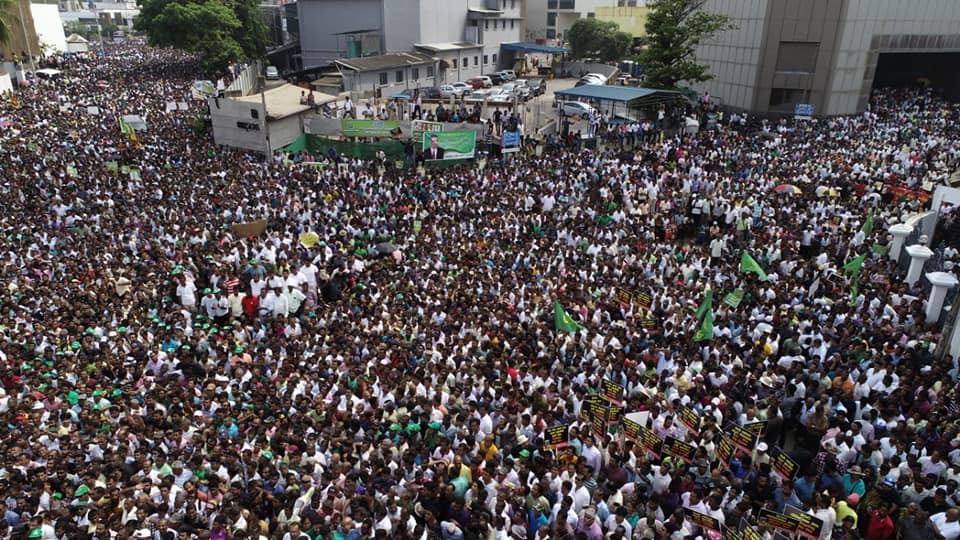 Thousands of protesters rallied behind ousted Prime Minister Ranil Wickremesinghe in front of his official residence in Colombo on Tuesday.
Thousands of protesters rallied behind ousted Prime Minister Ranil Wickremesinghe in front of his official residence in Colombo on Tuesday.
The international community at large has yet to recognize Mahinda Rajapaksa as Prime Minister. On Tuesday, British Foreign Secretary Jeremy Hunt told the House of Commons that he would raise the point that President Sirisena’s actions contravene the 19th Amendment and that they’re “concerned about the safety of Prime Minister Wickremesinghe.”
The same day, Chairman of the International Democratic Union and former Canadian Prime Minister Stephen Harper issued a strong statement, that said, “we are witnessing the breakdown of democracy in Sri Lanka.”
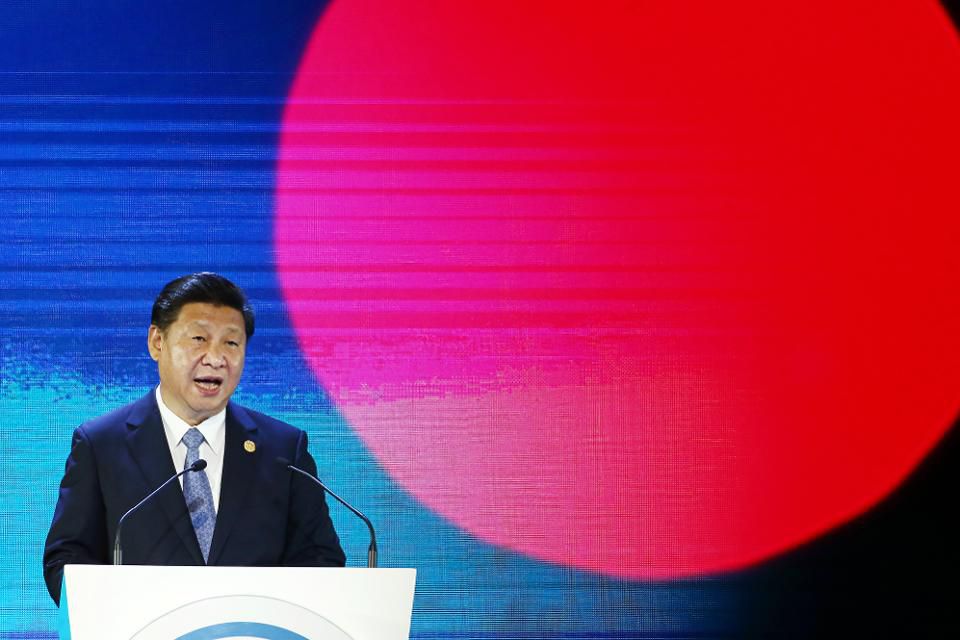
China Cannot Turn The Philippines Into Another Sri Lanka
By
China cannot do to the Philippines what it did to Sri Lanka -- use the “debt trap” to acquire key sea outposts -- because the Philippines economy doesn’t resemble Sri Lanka’s.
Sri Lanka’s debt trap saga began with Beijing lending that country funds needed to have its ports upgraded by Chinese construction companies. When Sri Lanka couldn’t pay back the loans, Beijing turned them into equity. And that gave China ownership and control of Sri Lanka’s two major ports.
Recently, China and the Philippines signed agreements for several infrastructure projects to be financed by Beijing. But there are a couple of things that make China's Sri Lanka strategy very unlikely in the case of the Philippines.
One of them is that the Philippines is better in managing foreign loans than Sri Lanka.
That’s according to Jay Batongbacal, director of the University of the Philippines' Institute for Maritime Affairs and Law of the Sea. “The Philippines is smarter and more experienced in managing loans,” Batongbacal’s quoted saying in GMA NEWS OLINE.
Apparently, Mr. Batongbacal is referring to the Philippines’ ability to avoid outright debt crises seen in other emerging market economies.
Then, there’s the size of the Philippines economy. The Philippines GDP is roughly four times that of Sri Lanka’s—see table.
Philippines vs Sri Lanka Key Economic Metrics
Source: Tradingeconomics.com
And there’s the state of the Philippines’s economy, which doesn’t run the risk of a debt crisis anytime soon, as Sri Lanka did early this year.
To begin with, the Philippines economy has been growing at a robust pace. As of the September quarter of 2018 the annual growth was standing at 6.1%—well above the 3.79% for the period 1982-2018.
Then there’s the country’s tamed Current Account deficit. It stands at 0.80%, close to the average of -0.45% for the period 1980-2017. That means that the country is living close to its means, thanks to remittances by overseas Filipinos, of course.
Most notably, government debt stands at 42.10% of GDP, well below the average of 56.25% for the period for the period 1990-2017, which makes it very unlikely that the country will run into any debt crisis any time soon.
And if it does, it has plenty of foreign reserves to deal with the situation. The Philippines’ Foreign Exchange Reserves stand at $74722 Million, well above the average of 16341.45 USD Million for the period 1960-2018.
These statistics stand in sharp contrast to those of Sri Lanka’s, where the GDP grew at an annual rate of 3.70% in 2018, well below the 5.88% average for the period 2003-2017.

Philippines Equity Market/KOYFIN
Sri Lanka is running a Current Account deficit of 2.60% of GDP, half of the -5.47% average for the period 1980-2017. That means that the country is living beyond its means, relying on foreign money to sustain its living standards.
That could explain the country’s large government debt, which stands at 77.60% of GDP—well above the average of 69.69% for the period 1950-2017.
Meanwhile, foreign Exchange Reserves stand at 1386166.90 LKR Million in July of 2018—well below the average of 250901.90 LKR Million for the period 1975-2018.
The bottom line: China cannot turn the Philippines into another Sri Lanka, because its economy is large and growing fast. Filipinos live within their means. And the country’s central bank has the foreign currency reserves to deal with the prospect of a debt crisis.
* Professor and Chair of the Department of Economics at LIU Post in New York.He also teaches at Columbia University.
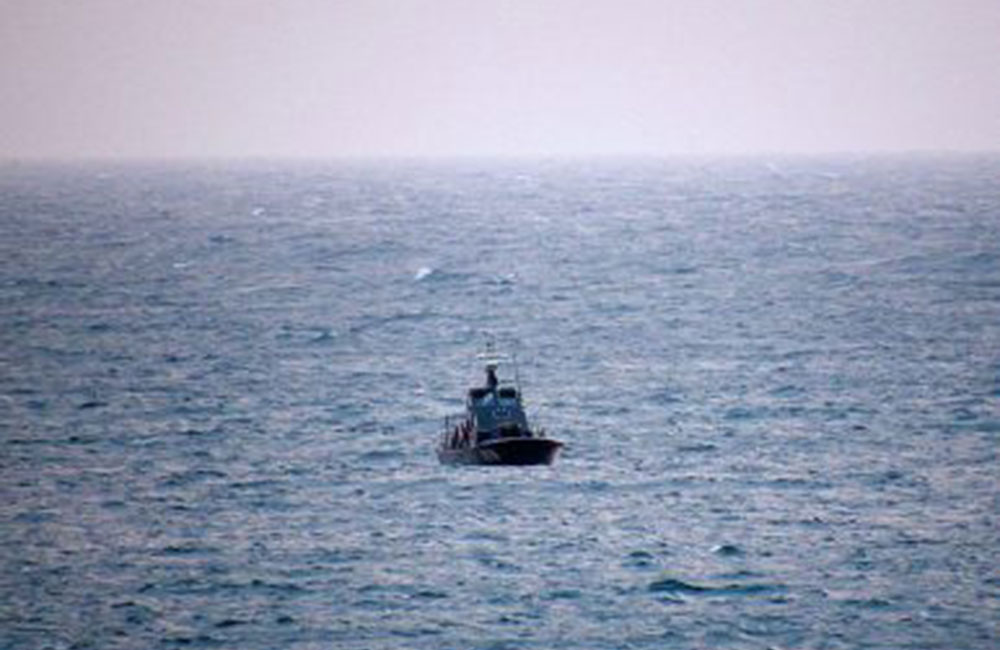
No Strings Attached? How Sri Lanka Can Make the Most of Security Grants
By Natasha Fernando
Sri Lanka is a middle-income country that is strategically located in the Indian Ocean. It emerged from a three-decade civil war and is now in a post-conflict era, struggling to maintain internal political and economic stability while maintaining friendly relations with the world. But Sri Lanka’s strategic location has led to geopolitical tensions among major powers, all seeking to further their ambitions in the Indian Ocean. Sri Lanka has thus seen the construction of Chinese funded ports, Indian management of national assets such as the Mattala airport, and Japanese aid.
Throughout its long battle with the Liberation Tigers of Tamil Ealam (LTTE), the Sri Lankan government received considerable amount of military equipment by way of sales from China, Pakistan, Russia, and Israel. After the defeat of the LTTE, Sri Lanka has no conventional military threat to face, but instead has to face many nontraditional security threats such as cyberattacks, piracy, illegal fishing, marine pollution, illegal migration, trafficking, and smuggling of illegal contraband, transnational organized crime, etc. Sri Lanka as a small island state has limited resources to counter these threats and against the current economic backdrop, foreign assistance is required – and it must be handled cautiously. Sri Lanka’s ability to obtain military equipment via credit lines is limited while donations are not always given in good faith. Hence, knowing how to strategically balance the receipt of donations and grants could be useful to Sri Lanka when facing the geopolitical game.
Sri Lanka’s Military Capability and Recent Military Donations
Sri Lanka’s military expenditure has seen an increase even after the end of the civil war in 2009. This is due to the need to maintain the troops and updated equipment, as well as the addition of new institutions over the years. The Sri Lanka Army, Navy, Air Force, Coast Guard, and Civil Security Department have both recurrent and capital expenditures, which even today account for the highest allocations of the budget.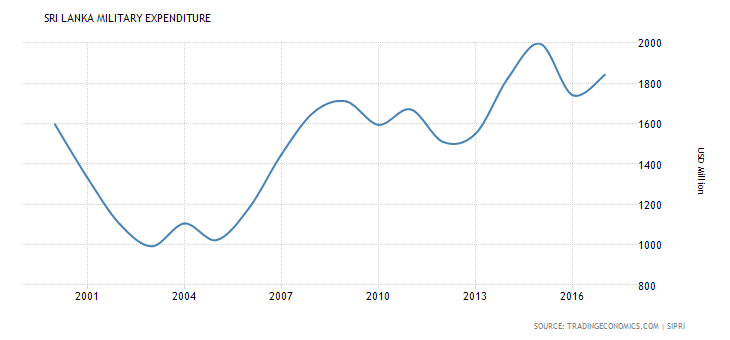
The current debt situation in the country is worse and is predicted to increase over the next years unless the government opens up new avenues for bilateral trade and more investment opportunities, allowing Sri Lanka to gain revenue by being part of global value chains. Although Sri Lanka’s vicious cycle of debt began with the previous government initiating large scale infrastructure developments, the present government’s mismanagement has resulted in the country falling even deeper into debt.
As the Institute of South Asian Studies has highlighted “in 2015 [the first year of the Sirisena administration], outstanding domestic debts rose by over 12 percent due to excessive government spending and foreign debt had increased by 25 percent by the end of that year.” Against such a backdrop, Sri Lanka is unable to enter into any agreements to acquire defense equipment via credit lines — no matter how important and necessary that equipment might be. 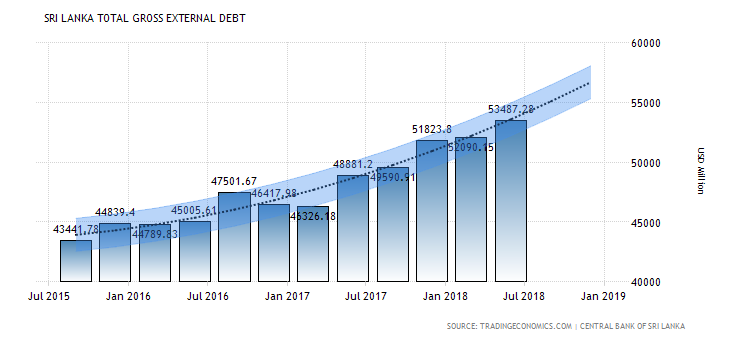
Strategizing Donations and Grants
Against this pitiful economic backdrop, Sri Lanka has very little choice but to accept military donations. In this year alone, China gifted Sri Lanka a frigate, and Zhou Chenming, a Beijing-based military commentator has predicted that “it is possible China will give [Sri Lanka] one or two more.”
Also in 2018 Japan donated two coast guard patrol vessels, SLCGS Samudra Raksha and SLCGS Samaraksha to Sri Lanka. The Japan International Cooperation Agency (JICA) is also to provide a grant aid of 1.83 billion yen ($16.3 million) for the Project for the Maritime Safety Capability Improvement.
Furthermore, the Australian government has provided two main engines for the Sri Lanka Navy Ship (SLNS) Mihikatha, which was a gift to Sri Lanka by Australia. Australia-Sri Lanka defense ties have been lucrative since 2013, when navy boats were donated to prevent human smuggling via maritime routes. India has also been quite active, providing both gifts of vessels as well as training for members of the Sri Lanka Coast Guard on ship handling, bridge navigation, engine room controls, and machinery.
But all these donations, gifts, and capacity building have been subject to various criticisms. These criticisms span anti-military sentiment by the Tamil diaspora and also concerns from domestic interests groups in Sri Lanka, as in the case of U.S. assistance. The Trump administration’s foreign assistance of US$3.4 million was criticized for being a tool of U.S. foreign policy, with the goal of to maintaining U.S. dominance in the Indian Ocean region. The United States is also developing ties with the Sri Lanka Navy for conducting training and joint exercises. Sri Lanka must be clear-eyed: extra-regional powers providing such assistance do so not entirely for charitable purposes but to also strengthen their own security and power.
Interestingly, the main donations in the maritime sphere for Sri Lanka have come from countries of the Quadrilateral Security Dialogue: the United States, Japan, Australia and India. This informal alliance has mainly been viewed as an attempt to control the rise of China. However, there are scholars who promote the idea that Quad countries should work together to promote freedom of navigation in the Indo-Pacific.
Conclusion
Countries will continue to engage in providing aid and assistance to Sri Lanka, whether their motives are pure or not, and Colombo has little choice in whether or not to accept such assistance owing to the current economic crisis. Sri Lanka should obtain donations, but with careful assessments of the benefits to the country’s security forces, as well as a careful reading into any legal agreements that might accompany even grants and donations.
Let us consider a hypothetical scenario: two countries have both expressed the intention to donate a surveillance frigate, but Country X has a condition that its engineers can engage in repairing and maintaining the surveillance equipment, and Country Y has no such condition attached. Choosing Country Y over X is a wiser choice, even if Country X is more powerful in terms of bargaining power and has better quality equipment. In this way, Sri Lanka can restrict conditions that might involve a subtle element of foreign intervention.
Having thus concluded, Sri Lanka does not have capacity to build its own weapons, ammunition, and vessels but may look into avenues that will enable them to join a value chain within a global or regional military industrial complex.
Natasha Fernando is Research Assistant at the Institute of National Security Studies, think tank of the Ministry of Defense, Sri Lanka. These opinions do not reflect the Government of Sri Lanka. Her views are independent.
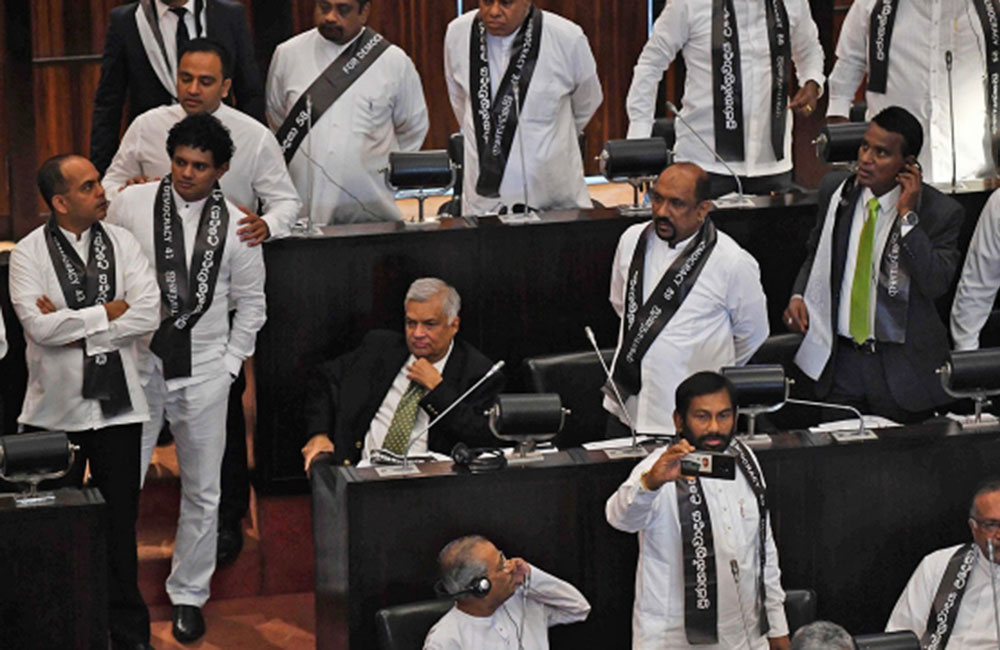
A bloodless coup in Sri Lanka is going awry
The schemes of Maithripala Sirisena, the president of Sri Lanka, are blowing up in his face. On November 13th the Supreme Court suspended his order dissolving parliament and calling a snap general election. The next day the reinstated parliament raucously approved a motion of no confidence against the government that the president had only just installed. It was a stinging rebuke to Mr Sirisena, who had stretched the constitution in his attempt to replace a supposed ally, Ranil Wickremesinghe (pictured, sitting), with a supposed enemy, Mahinda Rajapaksa.
The president has put Sri Lanka in a constitutional quandary. It now has no clear government. Mr Rajapaksa’s team have occupied all the ministries, but Mr Wickremesinghe’s insists that it remains the legitimate cabinet. “We went from one prime minister to two prime ministers to no prime minister in a span of 20 days,” says Thishya Weragoda, a bemused lawyer.
The crisis began on October 26th, when Mr Sirisena abruptly sacked Mr Wickremesinghe’s government—a power the constitution reserves for parliament, under an amendment Mr Sirisena himself ushered into law. The president denounced Mr Wickremesinghe as arrogant and stubborn. He replaced him with Mr Rajapaksa, a populist former president in whose cabinet Mr Sirisena had served from 2005 to 2014, before allying with Mr Wickremesinghe to defeat Mr Rajapaksa in the presidential election the following year. Mr Sirisena later accused Mr Rajapaksa of corruption and even of plotting to kill him.
Mr Sirisena now insists that Mr Rajapaksa is the best candidate for prime minister. To avoid learning parliament’s view, he suspended it for three weeks. Meanwhile, he swore in a new cabinet. But Mr Wickremesinghe refused to give way, calling his sacking illegal. The bureaucracy fell into near paralysis.
In response to growing pressure, Mr Sirisena grudgingly called for the legislature to convene on November 14th. He gambled on gaining the required 113 votes in the 225-seat parliament to validate Mr Rajapaksa’s appointment. MPs claim they were offered cabinet portfolios and millions of dollars to support the new order. Even so the numbers looked to be falling well short. So on November 9th Mr Sirisena dissolved parliament altogether and announced a snap election—again, a move that appeared to exceed his constitutional authority.
Mr Wickremesinghe’s backers complained to the Supreme Court. After two days of hearings, the three-judge bench—including the chief justice recently appointed by Mr Sirisena—suspended the presidential decree dissolving parliament. The ruling applies until December 7th, when the court will take up the case again.
That led to chaotic scenes in parliament. Mr Sirisena did not turn up to deliver the president’s customary statement at a re-opening. Mr Rajapaksa took the seat allotted to the prime minister. His supporters disrupted attempts to vote on the no-confidence motion with a show of hands, so 122 MPs signed a letter saying they had voted for it. The speaker notified Mr Sirisena, who declared the vote irrelevant.
Mr Rajapaksa’s supporters are defiant. Dinesh Gunawardena, an MP, tweeted that they would not accept the decision as “there was no vote taken”. They argue the speaker is biased. But in a triumphant press conference, Mr Wickremesinghe warned police and public officials not to follow “illegal orders from the purported government that has failed to demonstrate the confidence of the people”. He invited Mr Rajapaksa to propose a fresh vote if he had difficulty accepting the legitimacy of the one that had already taken place. Mr Wickremesinghe said his administration will take steps to ensure the government in place before October 26th will continue. How he will do that remains to be seen.
Mr Sirisena, angry and defiant, retains nominal control of the army and police while Mr Rajapaksa, sullen and chagrined, enjoys widespread public support. That is the crowning irony: had he simply waited for elections in two years’ time, he would probably have walked into the job.
This article appeared in the Asia section of the print edition of Economist under the headline "Putsch-tush"
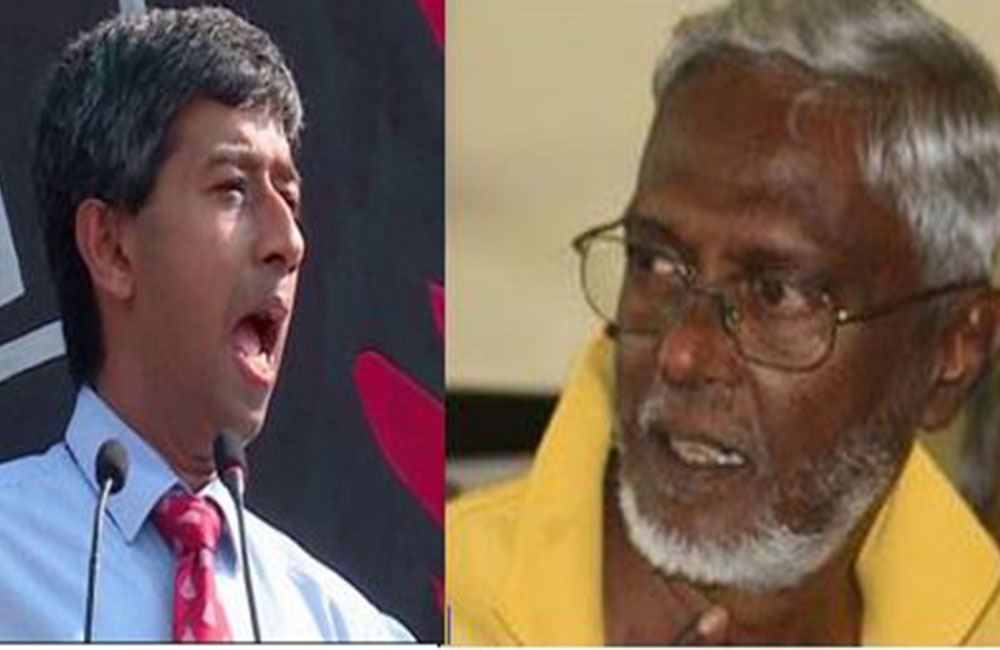
GMOA leadership far worse than “illiterates”
By Kusal Perera
All these 02 years, I have called the GMOA leadership an arrogant, professionally sectarian, unprincipled and a greedy leadership, when discussing their stand on the SAITM medical faculty, their claim in safeguarding “free education” and about the Sri Lanka Medical Council (SLMC).
Ironically, the GMOA leadership could not answer any of my arguments and assertions all through these 02 years, when they had the “right of reply” in all media I contributed to. They therefore took to slandering and insulting, first indirectly and by innuendo and then by name in their media briefings.
Most recently on 15 October, they wrote in their plead to HE the President, “While third class efforts are made to create a public opinion against the medical council, by using people like Saman Rathnapriya, Ravi Kumudash and Kusal Perera, an arrogant attempt to change the medical ordinance by him (ref. to Minister Senaratne) is also evident”.
On the same day in the “internal memo” to branch unions they say, “He (Minister Senaratne) further claims, that the demand to abolish the medical ordinance was made by persons such as Saman Rathnapriya, Ravi Kumudesh and Kusal Perera.”
This is all I had to say about these GMOA slanders, when I wrote my Friday article to the Daily Mirror (DM).
“While I do not know what the other 02 persons named by the GMOA leaders had to do with this restructuring of the SLMC through a new law, I take pride if the Hon. Minister had heeded my arguments and requests to enact a new law and overhaul the present SLMC to include other professionals and reputed and recognised laymen and women.” (19 Oct. 2018)
I have written about this necessity in both DM and Irida Lakbima, a position the GMOA leadership could not rationally challenge.
Frustrated they cannot intellectually and intelligently reply to all that is been said about the bankruptcy and professional bias of the SLMC and the necessity to therefore change the law to establish a broad based, independent and people centred SLMC, the GMOA leadership has sent a SMS directly insulting and slandering me that in full is as follows ; “Kusal Perera hired by Rajitha to attack doctors. He demand laymen to hold SLMC inquiries on Negligence even for traffic accidents by doctors. For details – gmoa.lk”.
I checked with their official website (https://www.gmoa.lk/) on 20 October around 13.20 hrs. There is nothing in it (unless in pages strictly for members), in relation to the SMS sent around to their membership, perhaps to about 10,000 government medical doctors. Fortunately, I am not as “nutty” as the GMOA leadership led by Dr. Padeniya, to demand such inquiries.
Also, please note, in all my writings, I have taken to task the GMOA leadership and not individual medical doctors, some of whom are in conversation with me. It is the GMOA leadership with Dr. Padeniya, I call a “mafia” that ruins the health service in the country.
With all these slanders instead of intellectual engagements, they prove I am right. My sympathies are with the silent majority in the GMOA membership who are also often bundled together with this “medical mafia” in public, a social nuisance by now.

An Open Letter To The Chinese Ambassador In Sri Lanka
By Prof. Liyanage Amarakeerthi
His Excellency, Mr. Cheng Xueyuan ,
Ambassador,
Chinese Embassy in Sri Lanka.
Dear Mr. Cheng Xueyuan ,
I hope this finds you well. I hope very much that you are extremely happy about Sri Lankan political mess to whose making you have contributed as well. I am a Sri Lankan citizen, a university professor and an honest tax payer and, by extension, a committed contributor to the huge repayment installments of the loans we have taken from your country.
I have seen the Hambantota Harbour from where you are able to launch military-naval activities of the Indian Ocean. You know what? I am extremely grateful to you for holding India at bay – I mean quite literally at ‘the Bay of Bengal.’ I have also seen the Shangri-La Hotel by the Galle Face Green – an imposing building that belittles the statue of our beloved former Prime Minister S.W.R.D. Bandaranaike. Recently, our equally beloved former secretary of defense, Mr. Gotabaya Rajapaksa held one of his political meetings at Shangri-la. Our villagers praise you to the sky for letting him have that epoch-making meeting at Shangri-La. Since those villagers sing your praise in Sinhala you might not understand it. Here I am reporting the facts to you. You know what your Excellency- if you help our hero GR to come to power you are certainly opening a crucial niche in the market for another Chinese product: White Van. Make them reliable, and user-friendly at night.
Slightly narrower with better ground clearance would be better so that those vans can traverse narrow and pot-holed streets on which normally under-paid journalists live.
Speaking of Shangri-La, your excellency, we did not bother about who owns that prime piece of land because you have come here to save us from the West and also from the North – the immediate north-India. India gave us Buddhism. But now, in order to protect that Buddhism, even from India, we need China. I know that you have brought us nothing but China. For example, even a little toy that my daughter plays with is from China. They are very good. For one thing, they break quickly so that my daughter does not have to play with a single set of toys for a long time. I go shopping in my own home town and buy some other toys which are also from China.
Apart from my daughter’s toys and the white vans I want you to export to us in future, I have another attachment to China. I am a big fan of Chinese literature. In my courses in comparative literature I often use Chinese literary works in Sinhala translations and Chinese literary theory in English translations. I do not read Chinese. But I am familiar with scholarly books by Stephen Owen, Earl Minor and others who have written wonderfully about Chinese literature and theory. I use some Chinese films in my classes, and To Raise the Red Lantern, Red shogun, and Farewell My Concubine are my all-time favorites. And there are many others that you might not particularly like because, as any good art work does, they are critical of the status quo of the society of their origin, i.e. the China you are ‘ambassadoring’ here.
So, your Excellency, you can see that I am more than qualified to write this letter to you. I am reporting a certain sentiment prevalent in my country these days. Following observations are not necessarily mine. Thus I have heard – to use a phrase found in canonical Buddhist texts:
Rumour has it that you are behind some of the political dealings taking place in our country today. You must have seen, if you have good Sinhala translators in the embassy, our beloved former minister S.B. Dissanayake trying to cut a deal with a parliamentarian on the opposite side. Did you see the number? I do not know how to write that number here. It is about RS 500 millions. How did they get that kind of money? India is known to be stingy even though she wants to be the regional super power. The US is an already an imperialist in her retirement- at least she pretends to be so. For many Sri Lankans you are the only source of political bribe-money circulated in my country today. People claim that that your Port-city, the other half of Hambantota harbour, a part of Colombo harbour, and other stuff, known and unknown, are at stake, and you are required to throw in a bit of cash. That much I have heard both in august assemblies and on the street.
Prompted by those rumours, here I am writing to you. In addition to being a university professor, I am working to build a truly democratic society that respects the rule of law. “Democracy” and “the rule of law” might not mean much in China. Over there, perhaps “rule by law” matters the most (That is also an argument heard everywhere in Sri Lanka.) But here, in my country, we have a long history of democracy- no matter how flawed that democracy is. If “democracy” sounds like something “crazy” to you, let me tell you this: some of us are working to build a socialist Sri Lanka. Does “socialist” sound familiar to you, your Excellency? Or is it already archaic in China? To achieve that (socialist Sri Lanka) I am working with a group of left parties. But if you throw in insane amount of Chinese money to our political scene, how can we practice principled politics? And you know very well that Embassies such as the US would not tolerate at least mildly socialist regimes. They are the ones who created the mass murders such as Pinochet's nearly everywhere. Now, despite your socialist history and the legacy of great Mao Zedong, you are bringing corrupted despots to power or supporting them to stay in power.
Your Excellency, if your money is used in the political game played here today, would you mind taking it back and holding onto it at least until the parliament of Sri Lanka resolves the crisis? After that you can invest that money in our country and bribe your way into winning huge development projects as you usually do (another fact heard on our streets), after the power struggles are settled domestically.
Please let us settle this issue ourselves and take your bribe-money back. If you happen to know other embassies that throw money into this insane game please forward this letter to them as well.
Thank you.
Sincerely yours.
Liyanage Amarakeerthi
Professor
University of Peradeniya

Are you ready for Asia's next financial crisis?
"Brighter prospects, optimistic markets, challenges ahead." That was the title of the IMF's World Economic Outlook update in January this year.
How quickly things have changed.
Since that report was published, turbulence, volatility and crises have dominated the economic landscape. Argentina is in crisis. Turkey is not far off. Markets have been rattled in Indonesia, Myanmar, Italy and Spain as financial conditions tighten.
The fallout from Brexit is more uncertain than ever. Populist politicians continue their rise. The trade war between the United States and China has escalated at an alarming rate.
The clock is ticking before the World Trade Organisation dispute settlement appellate body shuts down. China's financial system remains problematic. The United States faces bitterly-contested Congressional and Presidential elections with a possible 2020 recession thrown into the mix. Geopolitical tensions remain high with Iran, North Korea and Russia.
With all these risks, it's an important time to review Asia's capacity to respond to economic crises. It is 10 years since the collapse of Lehman Brothers, and just last year was the 20th anniversary of the Asian financial crisis. Should Asia plunge into another crisis, would we be ready?
The East Asian Bureau of Economic Research at the Australian National University this week released a report to be discussed at a forum of experts around the International Monetary Fund and World Bank meetings in Bali. The report assesses the capacity of global institutions such as the IMF to respond in different crisis scenarios. The news is not good.
The resources of the IMF have been increased substantially since the crisis. But with more countries calling on those resources, have they been increased by enough? Are the IMF's lending facilities flexible enough? Will countries go to the IMF if they get into trouble? Or does the IMF's reputation since the Asian financial crisis haunt it still?
Since the Asian financial crisis, a plethora of regional financing mechanisms have been developed, particularly in Asia. The authors explore what role these institutions, such as the Chiang Mai Initiative Multilateralisation, must play in supporting stability. Do these regional financing mechanisms compete with or complement the IMF? How would they work together in a crisis, given they are untested?
One line of defence is bilateral currency swap lines. Swap lines with the US Federal Reserve, some of which are still in place today, were integral during the global financial crisis. China has since created its own swap lines worth almost half a trillion dollars. It's not clear that these swap lines should be considered part of the safety net. Do central banks agree on whether they be available in times of crisis? How should they relate to the IMF, regional mechanisms and development banks?
Much can be done domestically to strengthen the resilience of Asia's economies and financial systems. This is what economies can do to prevent themselves from having to access the safety net in the first place. Regional forums like APEC may also be able to play a role in this process.
In the report, Edwin Truman issues a blunt warning: "Neither Asia nor the global financial safety net is ready for the next crisis." Truman suggests three reasons for this.
There is a lack of consensus about the purpose of the safety net and the place of the regional mechanisms within it. US Treasury Secretary Steve Mnuchin recently stated that the IMF's resources were adequate. The problem with his statement, warns Truman, is that the adequacy of the IMF cannot be assessed outside of a crisis.
Threats to the size of the resources of the IMF are emerging. In 2020, the bilateral loans to the IMF will begin to expire. In 2022, the IMF's New Arrangements to Borrow will begin to expire as well. The worst-case scenario is that the IMF loses half of its funding, greatly threatening its ability to respond to crises.
Truman finally warns that the mechanisms to manage the safety net are not agreed. Even if adequate IMF financial resources were assured, a consensus on how to manage them in support of the safety net as a liquidity support mechanism has not been established. Moral hazard concerns prevent the IMF from providing resources at the necessary scale while central banks require, at a minimum, that the IMF has both sufficient resources and the policy clout for them to get involved.
In short, neither Asia nor the global financial safety net is prepared for the next crisis. The message to policymakers is clear: now is the time to strengthen the global financial safety net. The old saying goes: "The best time to plant a tree is 20 years ago. The second-best time is now." The same is true when it comes to preparing for Asia's next economic crises.
Adam Trigg is Research Fellow in the East Asian Bureau of Economic Research and on the Editorial Board of East Asia Forum (www.eastasiaforum.org) in the Crawford School of Public Policy at the Australian National University.
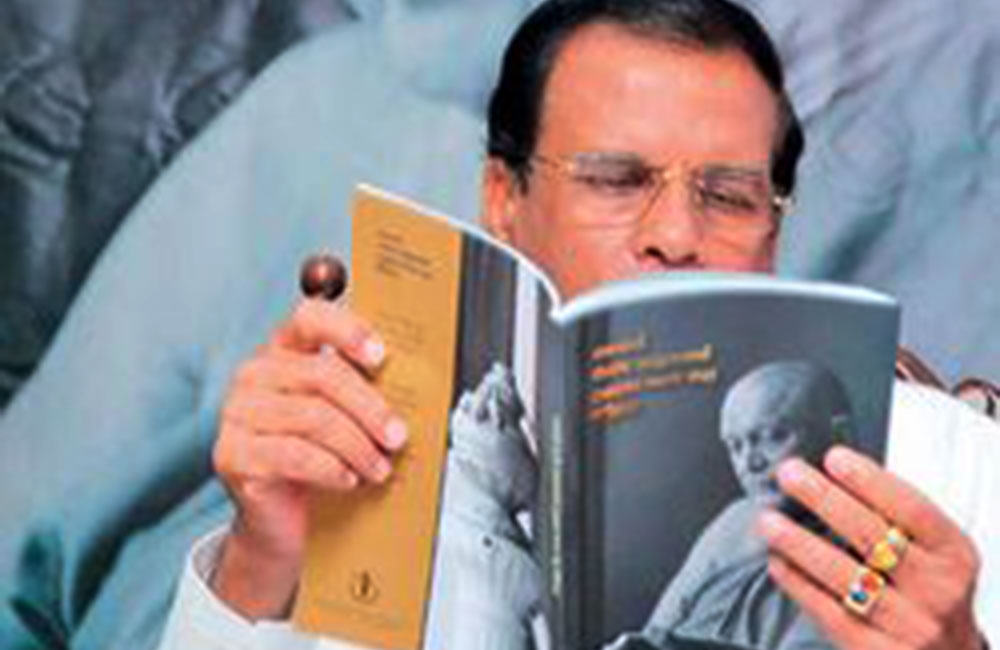
The Political Is Personal - An Essay in Despair
By Prof. Jayadeva Uyangoda
“My country has been betrayed again” –Pablo Neruda, Memoirs
In his explanation of why he removed Ranil Wickremesinghe from the office of Prime Minister, President Maithripala Sirisena cited policy and personal differences between the two.
An analysis of his speech shows that personal reasons are stronger than policy reasons and the personal is very much political. The text of President Sirisena’s address to the nation reminds the citizens of the explanation he offered in the latter part of 2014 as to why he left his former political boss, Mr. Mahinda Rajapaksa. There too, the personal was political.
In this note, I will try to show how, after October 26, the political is personal and devastatingly personal for me.
October 26 was a Friday. Although I am not a superstitious person, I look back at that rainy, gloomy Friday as the day I felt personally betrayed too. I can no longer think of Mr. Maithripala Sirisena as a symbol of political hope for the citizens of this country, and particularly for the younger generation. His actions that Friday marked a shockingly tragic end to the political hope and promise he had epitomised since November 21, 2014.
I campaigned actively for the newly formed opposition front, which fielded Mr. Sirisena as its Presidential candidate for the 2015 January election. I did so primarily because of Mr. Sirisena, or Maithri, as we began to call him affectionately. If Ranil were the candidate, I would have just voted for him merely as an act of protest against Mr. Mahinda Rajapaksa, but would not have actively campaigned for his victory. It is Maithri who made me active in electoral politics again, against a backdrop of many political disappointments with other leaders, including Chandrika and Ranil.
For me voting for Rail was purely instrumentalist. In contrast, campaigning for Maithri was a politico-moral duty.
Not only me. 51.28 percent of Sri Lankan voters found that at last there was now a man they could trust, identify themselves with, and entrust their democratic political destinies. He was actually the last hope of democracy in Sri Lanka, at a time when Sri Lankan politics under the existing regime, was moving in the direction of what we political scientists call ‘hard authoritarianism.’
To stop that nightmarish drift, a regime change was needed. For a regime change, a credible presidential candidate other than Ranil Wickremesinghe was needed. A man or woman who could personify the democratic political hopes of future generations of our citizens, particularly the young ones and first-time voters, needed. The new leader had to be one who had not earlier tasted political power as a government leader, and therefore unsullied by a record of corruption, abuse of power, megalomania and personalised rule, and limitless political ambitions.
Maithripala Sirisena fit the bill. He could turn the tide of political despair and cynicism. Somewhere towards the end of November 2014, two young vegetable sellers in rural Neluwa, Hiniduma, articulated to me in simple language the hope that I too had shared: “Who else can we trust except Maithri?’
And Maithri was willing to take tremendous personal risks. His daughter has now narrated in detail all these risks in her glossy political biography of her father.
It was the ethicality of candidate Sirisena’s message that had the greatest political aesthetics in 2015. Sri Lanka needed a new leader who valued political morality over ambition and compassion over the ruthlessness of power. It is the political morality of Maithri’s slogan yahapaalanya that fired the political imagination of more than half of Sri Lankan voters in 2015.
By 2015 I had not ever met Mr. Maithripala Sirisena. I had only seen him once in 2002 at the Shanthi Vihar Restaurant, near University of Colombo. At that time, he was out of power, but still the General Secretary of the SLFP. He was wearing a pair of trousers and a long sleeved, and slightly oversized, white shirt. A former GA of Polonnaruwa, whom I knew, and two others were at the lunch table. When I talked to the former GA across the lunch table, Mr. Sirisena and I only shared mild smiles.
My absolute lack of personal acquaintance with Mr. Sirisena did not prevent me from developing a personal admiration for him. In his public persona, I saw him as a mild mannered, gentle, and restrained individual with no ruthless political ambitions. Based on that judgment which now appears to me naive, I reached a political conclusion: To personify the hopes and aspirations of democratic revival in Sri Lanka, we needed a man or woman of gentle and kind disposition with moderate temperament who would not have the inner capacity to become a hardline ruler. Democracy is after all a government by the moderates who would exercise political power, being aware of, and faithful to, its inherent limits.
For this essential personal requirement of a democratic politician, Sirisena was insulted, slighted, and ridiculed by some of his opponents, calling him by abusive nicknames. And all of them have now begun, after October 26, to admire him and see great political virtues in him, of course, for wrong and utterly opportunistic reasons.
After he became Sri Lanka’s president, I have met Mr. Sirisena probably less than five times. I found him to be a charming and sincere political leader, not corrupted by the pretensions of the Colombo’s political elite. My first face –to- face meeting with him rekindled another naïve illusion I had been maintaining: a politician with rural social background and uncorrupted by urban class arrogance and sophistication would be a better democrat.
We all knew that President Sirisena and his Prime Minister failed to develop a stable working relationship to lead the government which they jointly formed.
We also knew that both leaders were not adequately sensitive to the popular mandate that brought them in to power in 2015. We also learned that our President and Prime Minister were amateurish in their political management of conflicts that occurred within the coalition government. We all were hoping against hope that the two leaders would not damage the process of Sri Lanka’s democratic recovery.
But, I never expected President Sirisena, amidst all the unpleasant political and personal problems he had with Prime Minister Wickremasinghe, to single handedly reverse Sri Lanka’s path to democratic recovery and consolidation. He did so by, as far as I understand the constitution, violating both the letter and spirit of the 19th Amendment of which he was a co-author. To justify that violation, he seems to have got legal advise, among others, from those who were pathologically opposed to the essence and spirit of 19th Amendment. Some others were political sycophants who saw a great chance in a President who has a not-so-strong understanding of the intricacies of constitutional law, in order to promote their own political self-interests.
The damage done on October 26 evening and continues to be done thereafter to Sri Lanka’s democracy, and the democratic futures of the young generation to which the children and grand children of both President Sirisena and I belong, is a devastating personal setback to me.
Now on, recovery of democracy for Sri Lanka’s next generation is likely to be preceded by another phase of grave violations, setbacks, violence, resistance, and tragically, bloodbath.
Thus, for me, political is the personal too.
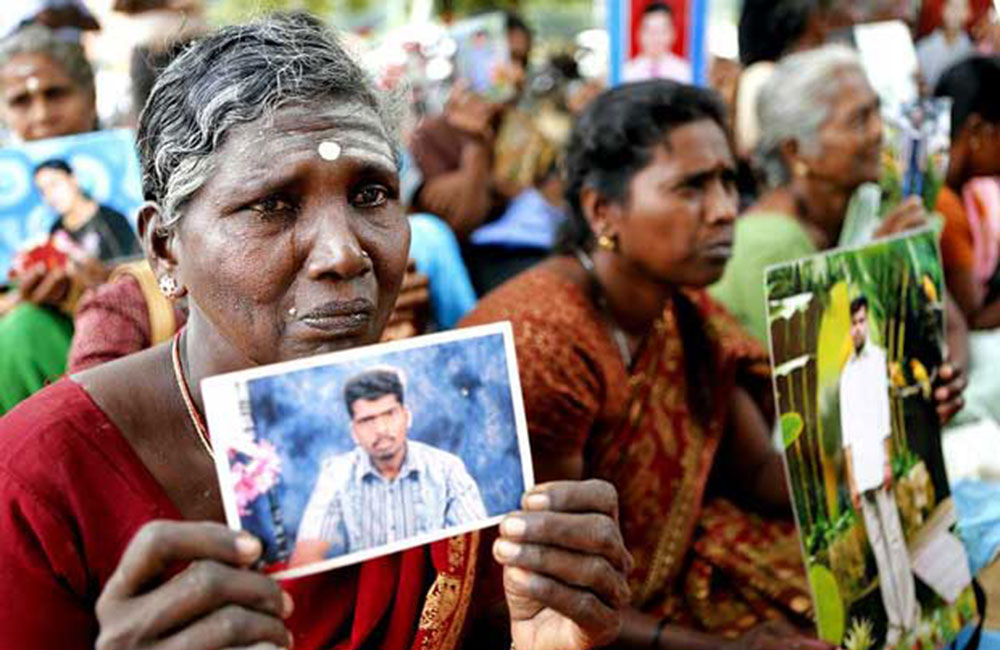
The Need for Reparations – Victims’ Stories
The Need for Reparations – Victims’ Stories
By Tharaka W.B. Hettiarachchi
Almost a decade after the end of the war, there is still a segment of Sri Lankan society continues to remain in the dark. For them even as the fighting has ceased, the suffering and trauma remain unchanged.
“When I am alone having lost my children and my family, I sometimes get the feeling why I should be living… On one side I am sad about losing my family. On the other side I’m longing for assistance.”
– Lady from Kilinochchi who lost her family
Providing reparations to victims is a crucial step in the healing process of a post war country such as Sri Lanka. The “Office for Reparations Bill’’, gazetted on 25th of June 2018, was submitted to the parliament on 17th of June 2018. All reparations related tasks/matters are to be handled by the Office for Reparations. However, granting reparations does not mean merely giving monetary compensation. There are many types of reparations that can be granted. Granting reparations demand a recognition that violations have occurred in the past. It also demands a fair and adequate method of determining the best form of reparation that can be provided based on the individual needs of victims. These matters are to be considered by the Office for Reparations (OR).
Many victims of violence have suffered human rights violations, and violations of humanitarian law. They are victims who have lost their family, their land, livelihoods, education and access to basic health services. Some are in need of psycho-social support to move on from the traumatic effects of war.
Bearing the pain of loss and the burden of poverty, a lady who now lives alone in Kilinochchi says:
“I had four babies but 3 of them were stillborn… In 1991 my son survived…when he was eight months old, my husband died. I lived in untold misery after that. It must be said that I lived in the dark. I don’t know wage labour but had to somehow earn and support my child. My wages were Rs 75.00 a day and I suffered even for food. When the child was three years I sent him to school. He studied up to O’Levels and after that he also entered as a wage labourer in 2007. He went to work so as to keep his mother happy. When he is delayed somewhere I search for him because I am happy only when he is at home. In 2008 when he went to work he was killed as a result of shelling. I searched for three days and discovered the truth. I cried and cried and am still crying.”
The OR is deemed to provide support to victims such as these. Reparations can be provided to those who have lost their family members. The OR will work together with other transitional justice mechanisms that are currently set in place in order to give the best possible remedies for victims. For example, in the case that a victim is a family member of a missing person, the OR can refer such persons to the Office of Missing Persons (OMP) in order that they can continue their search for the missing and to ascertain the truth about what happened through the relevant organizations. The OR can also receive applications from the OMP regarding victims that are in need of reparations. Reparations can also provide socio-economic support for those who need to find a stable and reliable source of income. Providing the opportunity to engage in training or skills development, being provided with welfare services, and payment of loans or monetary benefits can empower war and conflict victims who are facing dire economic conditions due to the effects of war and violence. The OR would be a beneficial and highly valuable mechanism by the state to help those who are motivated and determined to move on from their plight of suffering, but who do not have the means to do so.
“I will build a house in my land and keep my son’s photograph and live in peace. My desire is to live on my own income. I must meet my expenses from the income of some self-employment… if I could build a house even if it be a hut. I must live there with no trouble to others.”
– Lady from Kilinochchi
Many victims living in poverty are simply in need of the chance to find a stable means of income.
“When I was pregnant with my first child, my husband was shot by the brutal LTTE terrorists… Now I sew and make bags out of palm leaves…But we don’t have a good sale.”
– Wife of a Sri Lankan Army soldier, Kurunegala (Letter 214)
“In the 1980’s, fighting was intense in our areas. Those days we were living in the jungle, among many difficulties with our children… Their education was disturbed as well. After the war we returned but there were difficulties to find a livelihood. All our property was lost.”
– Victim from Ampara District (CTF Report)
According to the OR Bill, the office is set to provide reparations for the loss of livelihoods, housing and other assets.
Physical disability and psychological trauma too are crucial aspects that need immediate attention in a post-war context. These issues are often overlooked as unimportant, and with the lack of support and assistance can have significant negative impact on victims. A large number of submissions were made to the Consultation Task Force on Reconciliation (CTF) regarding the difficulties faced by disabled war victims (including former SLA soldiers) and the neglect they have faced as a result of it. Some cannot find work due to their disability and some are not treated because their disability is not recognized as a priority to begin with. As part of the reparations process, the OR is set to provide adequate and necessary healthcare to war and conflict victims. This includes providing special attention to those with disabilities. Physical disability is one of the many consequences of war that lead to psychological trauma.
“Before we got married, my husband got disabled in 1991, while fighting in Welioya. He is deaf in both ears…my husband lost his job. After sacrificing so much for the country, he must be feeling so sad… My child’s mental strength has also deteriorated. We request some assistance…”
– Wife of disabled soldier, Kurunegala (Tree of Life 1)
This is an example of the clear demand made by the victims. Victim centrality is one of the key principles to be followed by the OR. A need based and adequate reparations mechanism will prove to be more effective in its aim to restore victim’s lives back to their original state, as well as to build victim’s trust in a coherent and reliable system. The OR is to be headed by experienced and qualified commissioners who will act independently, not conforming to changing government interests or political biases. The primary focus should be on the victims and their needs. They want an end to the years of suffering, and look for help and support to build a better future. It is the duty of the government to empower these people who are fellow citizens of the country. They have a right to receive reparation for the violations they have endured and an effective reparation mechanism cannot be delayed for longer.
(Quoted from: – The Herstories Project at www.herstoryarchive.org. This is an online archive of war-affected women’s memories collected between 2012-2013 by Radhika Hettiarachchi and Viluthu Centre for Human Resources Development. – Final Report of the Consultation Task Force on Reconciliation Mechanisms – Volume I)
Page 6 of 11
